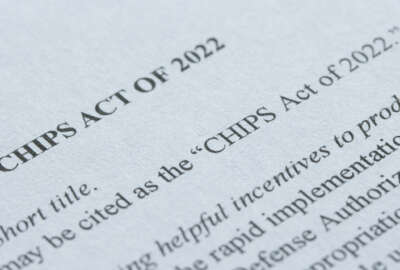FEMA is still on the hook for several pandemic-related expenses
FEMA used disaster relief funds to cover the costs of vaccinations and testing sites, among other things.
Lot of firsts occurred during the pandemic. Among them: the first time the Federal Emergency Management Agency used its Disaster Relief Fund to respond to a nationwide public health emergency. FEMA used the funds to cover the costs of vaccinations and testing sites, among other things. Government Accountability Office has found FEMA may have underestimated just how much would be required. For more, Federal News Network’s Eric White spoke to the GAO’s director of homeland security and justice issues, Chris Currie.
Interview transcript:
Chris Currie The COVID-19 pandemic, surprising in a number of ways. I think most people are surprised to even know that FEMA was involved in the response because they think of hurricanes and natural disasters, but FEMA has a large fund of money that’s very flexible to use in the case of emergencies. And, so, it was definitely tapped into in the COVID-19 pandemic. So, one of the things that the appropriations committees wanted us to look at is just seeing how large the costs were getting out of the pandemic for FEMA. They wanted us to look at the effect on the disaster relief fund long term, and also just how good of a job FEMA was doing in anticipating some of these costs. And, as you set up, they they blew well past their initial estimates. Initial estimates right out of the bat, which understandably, were, you know, there wasn’t as much information, were around 20 billion, and FEMA now estimates it’s going to spend about $171 billion by the end of fiscal year 2026.
Eric White It was just crazy time for all of us. Was that lack of knowledge just due to the fact that nothing had ever happened like this before, A, and, B, FEMA had never had to deal with anything like this before.
Chris Currie It is true. I mean, it’s impossible to see the future and no one had a crystal ball in 2020 to see how big of a problem this is going to be and how much it was going to cost. But I think that there were a number of places, as the pandemic wore on, where estimates probably could have been a little bit more realistic and accurate. FEMA sort of re-baselined their estimates at different stages, and at each point, they underestimated what it was going to cost. For example, in 2021, the President authorized basically FEMA to cover 100% of costs. Usually, with its programs, they cover 75%, the state or the local governments covered 25%. It went to 100%. So, at that point, I think it was reasonable to expect that states were going to start sending in a lot more projects and requests just given that we’re going to be 100% federally funded. And so all along, they just continue to underestimate the cost.
Eric White Yeah, is this sort of thing a, you know, it’s never used this for a public health emergency, but has it used the DRF funds for other matter or other disasters where certain things were required, you know, such as, you know, personal protective gear and things of that nature, or, you know, even just setting up sites? You know, it’s all very similar to what FEMA does for other disasters, right?
Chris Currie You’re right, you make a good point, because a lot of what FEMA was doing is providing equipment, and logistical capability to get equipment to different places, and to get things where they needed to be, which is what FEMA does in a disaster. So, while the pandemic, the scale of it was unprecedented, you know, 59 individual disaster declarations, the operation was not unforeseen or unprecedented. And this is a really important point we were trying to get across to FEMA and they didn’t really agree with us on, but, you know, their response to our findings and our recommendation was that they don’t expect to have to respond to a pandemic like this again, and they don’t expect to be asked to do something like this again, which, that could be true. None of us know. But what the point we were making is there are a number of different scenarios, whether it’s a cyber attack, whether it’s a wide scale, multi-state disaster, whether it’s multiple concurrent disasters in different states across the whole country. There’s a number of scenarios where they are going to have to manage a huge response and recovery operation that potentially is going to be very, very difficult to estimate. So, that’s the reason we actually recommended that they do a better job of trying to develop these estimates, rather than just trying to forget the pandemic and move on with business as usual.
Eric White We’re speaking with Chris Currie. He is the director of homeland security and justice issues with the Government Accountability Office. Yes, so what’s at stake here of not getting those estimates right? Where does the DRF currently stand, because FEMA is still obligated to spend some, mostly, unfortunately, funeral funds towards this disaster declaration? You know, what is going to happen if these estimates aren’t as accurate as they could be?
Chris Currie It’s a big problem. Right now, today, FEMA estimates there’s going to be a $6 billion shortfall in the disaster relief fund by the end of September. And, remember, that is also with almost a $35 billion appropriation earlier this year for this fiscal year 24 appropriations bill. So, the DRF was replenished and that quickly it’s back going to be in the red, and they’re likely to get another annual appropriation, which will help a little bit, but what the COVID-19 pandemic has done to FEMA is it’s essentially put it in a position where it’s going to be behind all the time with the DRF. And, of course, it’s going to need supplemental appropriations from here on out. Now, that’s just with what we know today. I mean, just, if we have another 2017, for example, where we have three huge concurrent disasters and wildfires, that’s only going to exacerbate the problem and going to require that much more in supplemental appropriations. Also, remember, this fund is used for recovery projects for disaster, it’s going back 20 years. Hurricane Katrina is still an open disaster. There’s still obligating dollars for infrastructure projects. So, if there’s no money in disaster relief funding, those past recoveries are sort of paused. That’s what FEMA did last year. And they do that so they can respond to things happening immediately, but it’s not sustainable for the long term.
Eric White Yeah, long term, I mean, is there maybe an over reliance on the fact that they’re always going to get that supplemental funding because there is nothing more direct of government services to citizens than disaster response? So, it is always something that gets front and center as soon as something happens. Do you sense there’s there may be an over reliance on that factor, rather than planning for long term when it comes to disaster relief spending?
Chris Currie Well, there absolutely, there is a reliance on supplemental spending. Congress caps the amount FEMA can get in the regular annual appropriation for the DRF. And, so, what that basically says is that if anything large happens in the country that year, you’re gonna need a supplemental. And, so, most of FEMA’s funding over the last 20 years has been in supplemental appropriations. It’s a massive amount. I mean, if you look back to 2017, they spent over $250 billion on disasters, which is just a huge amount. That’s, you know, six times DHS’s annual budget. So, what COVID did was it just it made this problem worse. And, so, it used to be where maybe they’d get behind toward the end of the fiscal year, and it would get replenished. Now, it seems like they’re behind multiple points of time in the fiscal year, which, you know, think about it. This requires Congress several times a year to try to add funding or attach funding to different bills, which requires those to get passed. And, that’s, you know, that can be difficult sometimes.
Eric White So as you mentioned, nobody can tell the future. What can be done to actually get some long term planning in some fiscal solvency for the DRF?
Chris Currie We just like to see more realistic estimates at different stages early on in the disaster, and a different way of doing this. And, so, in month one after disaster, it’s really difficult. All right, I mean, if you have a huge hurricane, maybe you don’t know if it’s going to cost you $10 billion, if it’s going to cost you $50 billion yet, but in month six, it the picture is starting to develop, you know what projects are going to, you know, come into play, you know how long it’s going to take. We want to see more accurate estimation quickly and that way Congress and the appropriations committees can then forecast out what they’re likely going to need to appropriate in the future.
Tom Temin Chris Currie, director for homeland security and justice issues at the Government Accountability Office, speaking with Federal News Network’s Eric White. Find this interview along with a link to the report at federalnewsnetwork.com/federaldrive.
Copyright © 2024 Federal News Network. All rights reserved. This website is not intended for users located within the European Economic Area.
Eric White is news anchor and Federal Drive producer at Federal News Network.
Follow @FEDERALNEWSCAST






